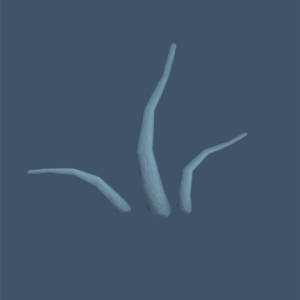Cilia: Difference between revisions
Oliveriver (talk | contribs) (Fill out cilia page) |
mNo edit summary |
||
| (One intermediate revision by one other user not shown) | |||
| Line 49: | Line 49: | ||
In real life, '''Cilia''' generally appear all over the exterior of a cell rather than in individual clumps. Cells with this coating are known as ciliates. | In real life, '''Cilia''' generally appear all over the exterior of a cell rather than in individual clumps. Cells with this coating are known as ciliates. | ||
Read more on this organelle's [https://en.wikipedia.org/wiki/Cilium Wikipedia page] | |||
Latest revision as of 20:24, 6 September 2024
| Organelle Details | |
|---|---|
| Cilia | |

| |
| Base Cost (MP) | 40 |
| Requires Nucleus | Yes |
| Processes | None |
| Enzymes | None |
| Size (Hexes) | 1 |
| Osmoregulation Cost | 1 |
| Storage | 0 |
| Unique | No |
| Upgrades | Pulling Cilia |
| Internal Name | cilia |
Small hairs on the outside of a cell which use ATP ![]() to increase cell rotation speed. Can be upgraded to generate currents that pull in prey cells and other objects.
to increase cell rotation speed. Can be upgraded to generate currents that pull in prey cells and other objects.
Requirements
A cell must have a Nucleus to evolve Cilia.
Processes
No processes.
Modifications
No modifications.
Effects
Each hex of Cilia increases a cell's rotation speed, consuming ATP ![]() in exchange for extra mobility. The exact improvement depends on the organelle's placement – those placed further away from the centre of a cell exert a greater moment of inertia, hence larger increase in rotation speed.
in exchange for extra mobility. The exact improvement depends on the organelle's placement – those placed further away from the centre of a cell exert a greater moment of inertia, hence larger increase in rotation speed.
Upgrades
Pulling Cilia
For 25 mutation points, modify Cilia once placed to transform them into Pulling Cilia. In addition to the regular effects of the organelle, Pulling Cilia generate vortices to attract small cells and chunks such as floating organelles.
Strategy
Cilia are essential for large cells, especially those relying on predation. Without them, large cells are hindered by sometimes painfully slow turning speeds. We recommend adding Cilia as soon as possible after evolving a Nucleus to counteract the enormous size of that crucial organelle, and we recommend placing them as far from the centre of a cell as possible to maximise turning force.
Scientific Background
Similar to Flagella, Cilia are thin hairs providing directional thrust, but they move in different configurations and also give other benefits. Many organisms use Cilia for sensory purposes and they can also push and pull nutrients around in larger organisms.
In real life, Cilia generally appear all over the exterior of a cell rather than in individual clumps. Cells with this coating are known as ciliates.
Read more on this organelle's Wikipedia page